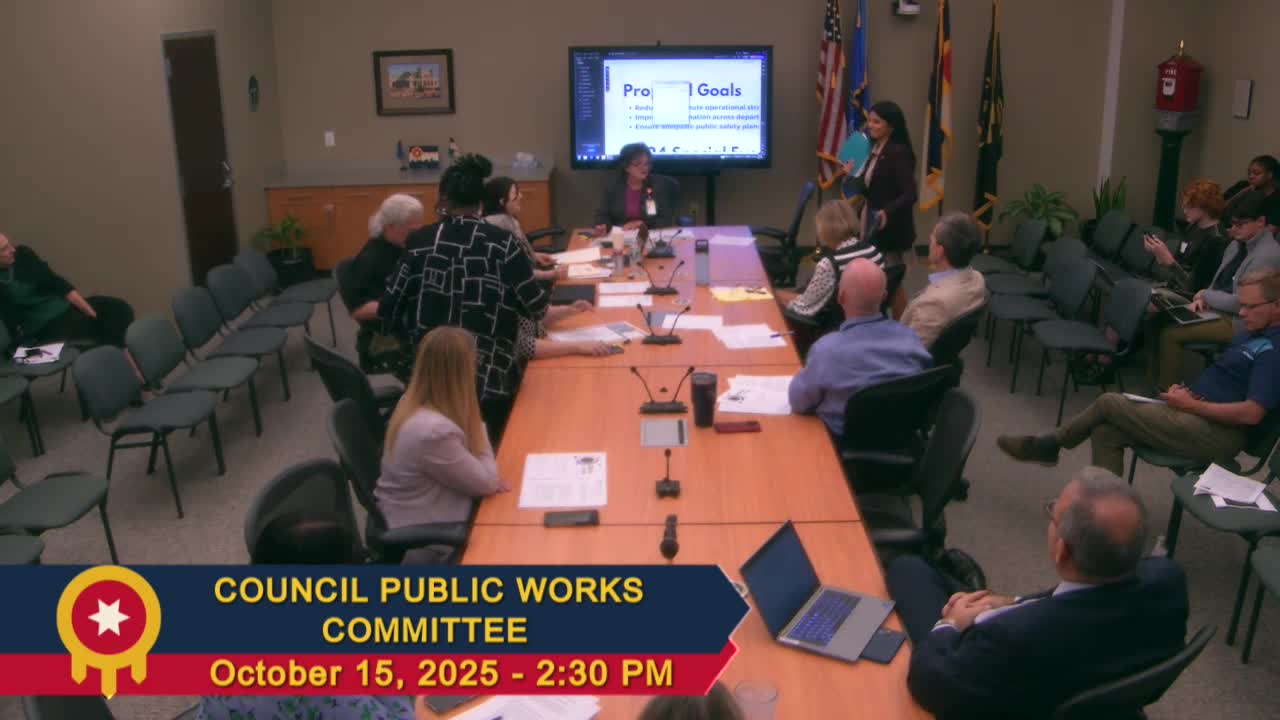City staff brief committee on fiscal health: reserves, use of fund balance and credit ratings
October 15, 2025 | Tulsa, Tulsa County, Oklahoma
This article was created by AI summarizing key points discussed. AI makes mistakes, so for full details and context, please refer to the video of the full meeting. Please report any errors so we can fix them. Report an error »

City finance staff provided the Public Works Committee with an overview of the city’s fiscal health, explaining why the city sometimes uses fund balance when setting a balanced budget and how the city manages reserves and monitoring.
Staff emphasized that city budgets must be balanced under state law and that available resources may include planned use of fund balance. Finance staff distinguished between a structurally balanced budget (preferred) and structural imbalance, which occurs when the city uses fund balance recurring-ly to cover ongoing costs. Staff said unreserved/unappropriated fund balance accumulates from prior years’ revenue over-performance and provides liquidity and a cushion for unexpected expenses.
Highlights provided to the committee included: the city’s general fund emergency-operating-reserve goal of 10% (staff said the reserve stood at about 9.9% after a 2023 draw related to the Father’s Day storm response); the charter-established economic stabilization (“rainy day”) reserve, which staff said has a balance of about $23 million (and is funded in part by a dedicated sales tax); and data points such as a cited $2.2 million current-year impact to the general fund from tax increment financing (TIF) districts and a recent decline in use-tax receipts since June (staff said the trend is being monitored and noted statewide factors including online sales and oil-and-gas sector activity).
Staff noted good external credit ratings from S&P Global and Moody’s, but said Moody’s cautioned the city to watch use of fund balance; continued year-over-year use of fund balance could prompt rating agencies to reconsider ratings. Committee members asked about triggers for drawing from the rainy day fund (staff said draws are limited and tied to year-over-year revenue decline triggers rather than a single missed projection) and about whether fund balance earns interest (staff said city assets are pooled and investment earnings are allocated by fund based on cash balances).
Staff recommended prudent use of fund balance for one-time costs (studies, pilot programs, capital outlays that reduce operating costs such as equipment) and cautioned against using fund balance to sustain ongoing operating expenses. Committee members asked for a historical chart showing unallocated/unappropriated fund balance changes over time; staff agreed to provide such a report. No formal council action was recorded in the supplied transcript; the session was a staff briefing and committee discussion.
Staff emphasized that city budgets must be balanced under state law and that available resources may include planned use of fund balance. Finance staff distinguished between a structurally balanced budget (preferred) and structural imbalance, which occurs when the city uses fund balance recurring-ly to cover ongoing costs. Staff said unreserved/unappropriated fund balance accumulates from prior years’ revenue over-performance and provides liquidity and a cushion for unexpected expenses.
Highlights provided to the committee included: the city’s general fund emergency-operating-reserve goal of 10% (staff said the reserve stood at about 9.9% after a 2023 draw related to the Father’s Day storm response); the charter-established economic stabilization (“rainy day”) reserve, which staff said has a balance of about $23 million (and is funded in part by a dedicated sales tax); and data points such as a cited $2.2 million current-year impact to the general fund from tax increment financing (TIF) districts and a recent decline in use-tax receipts since June (staff said the trend is being monitored and noted statewide factors including online sales and oil-and-gas sector activity).
Staff noted good external credit ratings from S&P Global and Moody’s, but said Moody’s cautioned the city to watch use of fund balance; continued year-over-year use of fund balance could prompt rating agencies to reconsider ratings. Committee members asked about triggers for drawing from the rainy day fund (staff said draws are limited and tied to year-over-year revenue decline triggers rather than a single missed projection) and about whether fund balance earns interest (staff said city assets are pooled and investment earnings are allocated by fund based on cash balances).
Staff recommended prudent use of fund balance for one-time costs (studies, pilot programs, capital outlays that reduce operating costs such as equipment) and cautioned against using fund balance to sustain ongoing operating expenses. Committee members asked for a historical chart showing unallocated/unappropriated fund balance changes over time; staff agreed to provide such a report. No formal council action was recorded in the supplied transcript; the session was a staff briefing and committee discussion.
View full meeting
This article is based on a recent meeting—watch the full video and explore the complete transcript for deeper insights into the discussion.
View full meeting
